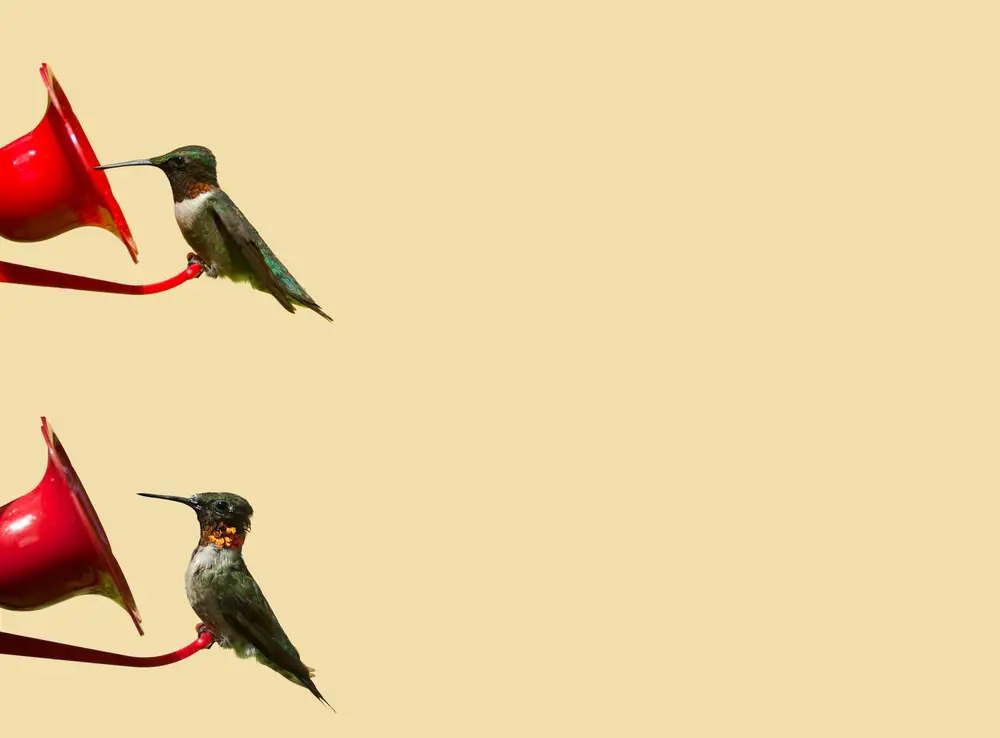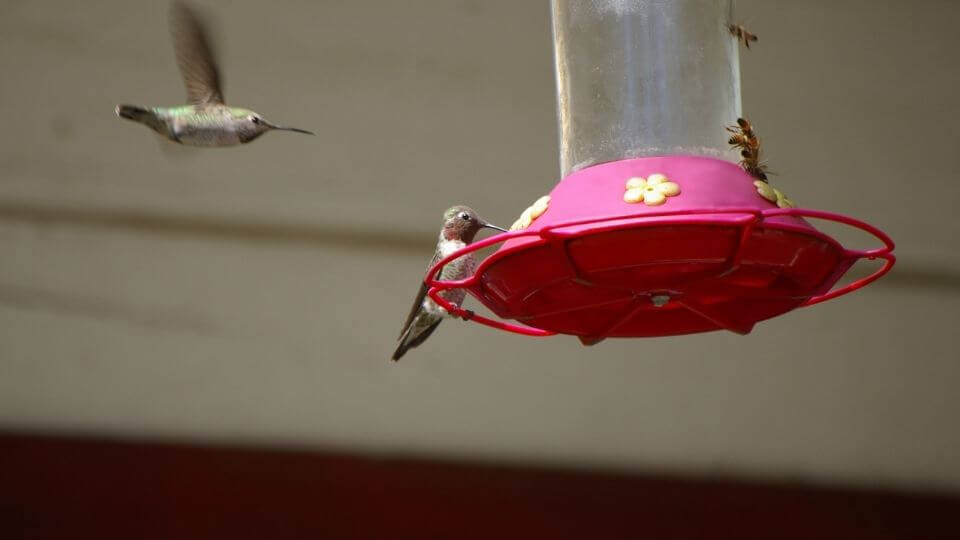Dealing with a hummingbird rescue can be challenging. If you visitor is displaying any of these sick hummingbird behaviors, make sure to consult with your local bird rehabilitation center, and take preventative measure to keep the hummingbird and surrounding animals safe.
Many viruses and bacteria are dangerous to hummingbirds, and many come from poorly maintained hummingbird feeders. It can be tricky to notice sick hummingbird behavior, as these small birds often go into torpor, which you might confuse with a dead hummingbird.
However, there are some other common symptoms of illness that can be seen in hummingbirds, which include: nasal or eye discharge, inability to eat, and lethargy. Sometimes, hummingbirds also get hurt, so you might have to jump to the rescue. If you’re sure that you have a sick or hurt hummingbird, know that taking care of it will require some preparation and skill. Here’s what you should know.

Table of Contents
What Are Some Symptoms of a Sick Hummingbird?
Hummingbirds always look like they’re full of life, but unfortunately, they can get sick too. If you’re a careful birdwatcher, you can easily notice a sick bird. A sick hummingbird might hover in one spot or shake. It might be limp, closed eyes, or hanging on the perch. Other common signs of a sick hummingbird include:
- not eating or drinking
- having trouble breathing
- nostrils, eyes, or beak discharge
- overall lack of energy
However, make sure to watch hummingbirds closely during the winter. You might easily confuse torpor with sickness. During torpor, hummingbird will sit on a branch, looking like they’re sick but just in hibernation. This mode helps them save energy during colder months. Don’t worry — their magnificent bodies already stocked up fat reserves. They don’t need to eat or drink during torpor; once their body temperature rises, they’ll wake up. One sure sign of torpor is hanging upside down.
If you’re unsure whether your little hummingbird visitor is ill, consult with a rehabilitation center that specializes in the care of hummingbird.
Common Hummingbird Diseases
Hummers are wild birds, and as such, they’re prone to various diseases. These diseases include:
- Candidiasis (fungal tongue infection)
- Avian Poxvirus
- Aspergillosis
- Salmonellosis
Each of these also has different symptoms. Here’s what to pay attention to.
Candidiasis – A fungal tongue infection, is among the most common illnesses among hummingbirds. The symptoms involve a swollen tongue, as this infection causes an unbalance in the bird’s digestive system. Hummers are usually infected via dirty stale feeders and from dirty water sources. This infection is often fatal since hummingbirds can’t utilize food sources properly and can easily starve. Treatment is provided only by a professional.
Avian Poxvirus – A growth of a tumor and wart-like growth on the hummingbird’s beak or head. This disease is contagious among hummers and transfers via direct, indirect contact and by mosquitos. Avian Poxvirus can also show on eyelids, feet, legs, beaks, and inside their mouths and could be fatal unless treated in time. Luckily, the majority of hummingbirds will recover in up to 4 weeks.
Aspergillosis is another common disease that attacks the hummer’s digestive system. It happens due to mold that’s present in uncleaned feeders. Once they catch this disease, hummingbirds have trouble eating and digesting, which causes death. Nasal discharge, diarrhea, and weight loss are the most common symptoms.
Salmonellosis – Can be caused by contaminated food sources, likely to cause disease in their digestive system. The symptoms include diarrhea, ruffled feathers, and lethargy.
Other pathogens that can affect hummingbirds include:
- Trichomoniasis: is a virus caused by parasites that infect the digestive and urinary tract systems.
- Haemoproteus parasites: a disease similar to malaria in humans.
- Intestinal adenovirus: causes infections in the respiratory and intestinal tract.
- Bacterial septicemia: bacteria that causes blood poisoning.
Hummingbirds are also susceptible to lice and mites. So much so that one research found 60% of feather mites in the tail feathers of Anna’s hummingbird. This type of mites destroys the feathers on the hummer’s head, exposing it to the sun. It can be especially deadly for baby hummingbirds if they fail to grow feathers quickly. Some insect invasions might cause the hummingbird to show signs of illness:
- Booklice
- Carpet beetles
- Cloth moths
- Spider beetles

Why Is the Hummingbird Just Sitting on the Feeder?
If you notice a hummingbird sitting on the feeder, it doesn’t mean it’s ill. Hummingbirds are highly territorial and will do whatever it takes to defend hummingbird food. They could also be simply exhausted if they recently fought for territory. Pay close attention to that hummingbird and see whether it shows any other signs of illnesses.
What Does It Mean if a Hummingbird Is Puffed Up?
Most adult hummingbirds will puff up when they’re trying to appear larger. This helps them fight off enemies and keep their territory intact. They could also do this when they’re ready to breed, so a puffed-up hummingbird isn’t necessarily sick. However, consult a vet or bird expert if other symptoms accompany puffiness.
Why Is the Hummingbird Shaking?
Hummingbirds may also shake, and it could be their normal behavior. They shiver during the night to cool off faster and acclimate to the surrounding temperature. They’ll then go into a dormant state. You might notice them shivering again in the morning to warm-up and restore their body temperature.
How Do You Help a Sick Hummingbird?
Wanting to help out a sick hummingbird is sweet. Still, remember that it’s illegal to keep, trap, or band hummingbirds unless you have a valid permit. If you do, you can use the eyedropper to deliver treatment or hummingbird nectar to the sick or injured hummingbird. Remember, hummingbirds are extremely sensitive tiny birds, and you must handle them carefully.
Consult with bird vets for proper treatment and stay in touch with rehabilitators — they usually know hummers inside and out. If you don’t have a permit and are afraid of treating the hummer, it’s best to call the rehabilitation center. However, it might take time for the rehabilitators to come to you, so you should try to take the hummer to them.
They’re qualified in the field and will know what to do. If you get stuck waiting for help to arrive, know that the time window for feeding the hummingbird is very low. They usually need to eat every 20 minutes, so your first action is to try to feed them.
What Do You Do With a Dying Hummingbird?
Unfortunately, sometimes bad things happen no matter how much you try to help. If you end up with a dying hummingbird and there’s nothing you can do, you should plan a disposal plan. Depending on your location, you might be able to bury it or give it to an authorized institution for cremation. If the dead hummingbird is banded, report it to the federal Bird Banding Laboratory at www.reportband.gov.
If the specimen is intact, you can reach out to researchers and pass the bird to someone who’ll use it for teaching. Get in touch with experts, and they’ll also teach you how to secure the bird until it gets picked up. Usually, they’ll ask you to gently wrap it in toilet paper, double-bag it in a zip lock bag, and write down the time of death and location. Then, you’ll likely have to preserve it in the freezer until it’s taken care of.
What to Do With an Injured Hummingbird?
Finding an injured hummer can be stressful. Still, ensure the bird’s safety by placing it in a shoebox or similar space. Keep them in a quiet place and handle them as little as possible. Depending on the situation, you can try to offer some nectar. Call the local bird vet or rehabilitation center for consultation on what to do and a potential treatment.
What if a Hummingbird Gets Trapped?
These wild animals might fly inside your home if you keep an open door or a window. Unfortunately, the inside of your place represents an additional danger for hummingbirds. Ceiling fans, inside pets, and windows could mean death for the trapped bird. If you notice a hummingbird got inside, you should act quickly:
- remove pets from the room
- open only one window
- try to keep the room and other windows dark
- chase the hummingbird around to get it out
- if it doesn’t fly through the window, wait until it is tired to gently grab it
What to Do With Potentially Sick Baby Birds?
Hummingbird moms can often transfer diseases to their baby hummingbirds. Unfortunately, you might have difficulty keeping an eye on the sick mom and her fledglings. Additionally, taking good care of ill babies is challenging. If you believe some hummingbird nests may have sick babies, contact a rehabilitation center for a consultation.
If you find little birds that just fell together with the nest, don’t separate them. Try to get the nest back where it was, but only if you know the exact location. If you notice baby hummingbirds that fell out, you can pick them up gently and return them to the nest. Remember that baby hummingbirds can’t regulate their body temperature on their own, so they might need your help.
Keep observing the nest and see if the mom comes back. She should feed the babies a few times every hour. The nest is likely abandoned if the chicks are chirping or the mom isn’t coming back. Again, contact the nearest Wildlife Rehabilitation center for a hummingbird rescue.
Measures of Prevention
Nobody wants a sick hummingbird, and luckily, there are many things you can do to prevent the diseases from spreading. First, ensure you always use the right mix for the hummingbird feeders. The hummingbird nectar is made of 1 part sugar and four parts water. Adding more sugar could result in candidiasis. Additionally, never use honey instead of sugar. When exposed to heat, honey easily ferments and can grow mold, yeast, and harmful pathogens.
When the temperature rises to 90 degrees and over, replace the nectar solution every one to 2 days. When the temperature drops below 70, you can restock the solution every 3 to 6 days. Don’t use red dye in the feeder solution, as it may harm the birds. Sugar water is the safest nectar recipe.
Check out Amazon for feeders with a wide mouth. Those are easier to clean. If your feeder gets so moldy that you can’t clean it properly, toss it and get a new one. Consider spreading out the feeding stations to avoid cross-contamination among the hummers. Avoid pesticides in your yard. That way, little insects won’t ingest poison and will stay safe for hummers to eat them.
Keep windows closed to prevent the hummers from entering your home. Furthermore, keep the feeders away from the doors and windows so the birds don’t come too close to your home. Hummingbirds may also easily get trapped inside spider webs. To prevent this from happening, remove all spider webs around feeders.
Final Word
If you’re an avid birdwatcher and notice something wrong with a hummingbird in your yard, your first instinct is to jump to the rescue. Still, dealing with hummingbirds is challenging, and if you’re not an expert, you will face hurdles. This is why it’s best to call a wildlife rehabilitator. They have the knowledge and expertise to deal with many types of diseases and injuries in these small birds.
Remember that they might take a while to reach you, so always be prepared to act. If nothing else, keep the feeders clean, use a proper sugar water recipe, and observe the birds, so you know if something happens.

